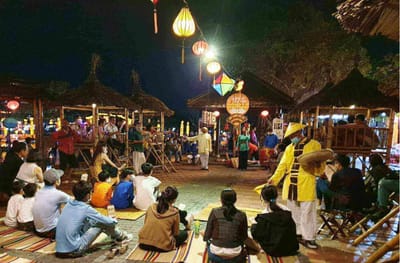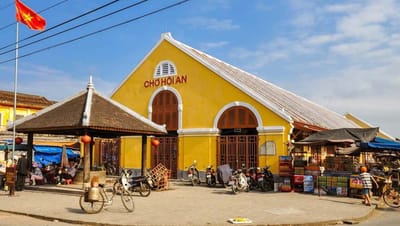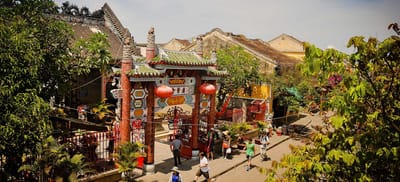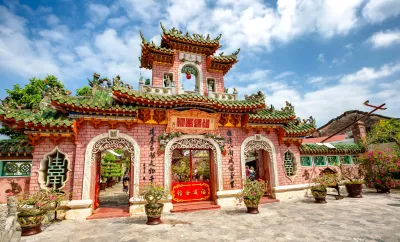Hoi An Old Town Ticket - Complete Entry Guide 2025

Hoi An Ancient Town's ticketing system balances heritage preservation funding with visitor access, creating a sustainable model for UNESCO World Heritage site management. Understanding this system—what it covers, how it functions, and how to optimize usage—transforms a potentially confusing administrative requirement into a strategic tool for meaningful cultural exploration.
Quick Facts: The Hoi An Old Town heritage ticket costs 120,000 VND (~$5 USD) and grants access to 5 attractions among 22 designated heritage sites including ancient houses, assembly halls, museums, and cultural centers. Tickets are purchased at 11 yellow booths around the ancient town perimeter, officially valid for one day though enforcement typically allows 2-3 days of use. The ticket is mandatory only for entering specific heritage buildings, not for walking the streets. Ticket revenue directly funds UNESCO site conservation and maintenance, making purchases a contribution to cultural preservation. Strategic site selection maximizes educational value and visitor experience within the 5-coupon limitation.
Understanding the Hoi An Ticket System
What the Ticket Covers
The Hoi An Old Town ticket operates on a coupon-based system designating entry permissions rather than area access:
Included in 120,000 VND ticket:
- Physical entry to 5 heritage sites selected from 22 eligible locations
- Unlimited walking access to ancient town streets (though technically required, street walking enforcement is inconsistent)
- Contribution to heritage conservation, site maintenance, and cultural programming
NOT requiring tickets:
- Walking and exploring ancient town streets
- Shopping in boutiques, tailor shops, and markets
- Dining in restaurants and cafes
- Photography in public spaces
- Visiting Hoi An Night Market
- Crossing the Japanese Covered Bridge before 9:00 AM
KEY DISTINCTION: The ticket grants ENTRY to specific heritage buildings, not permission to walk the streets. You can explore most of Hoi An's atmosphere, dine, shop, and photograph freely without purchasing a ticket. However, entering ancient houses, assembly halls, museums, and certain cultural sites requires using one of your 5 coupons.
Current Ticket Pricing (2025)
Standard Rate: 120,000 VND per person (~$5-6 USD depending on exchange rates)
Free Admission Categories:
- Children under 15 years (ID or birth certificate required for verification)
- Vietnamese citizens (national ID required)
- December 4th annually (UNESCO World Heritage listing anniversary)
Student Discounts: Some sources mention discounted rates for students with valid international student ID cards; inquire at ticket booths for current policy.
Ticket Format & Validity
Physical tickets consist of a card with five detachable coupons, each representing one heritage site entry. Upon entering a ticketed location, staff tear or stamp one coupon. Once all five coupons are used, the ticket becomes invalid for additional heritage site entries.
Official Validity: One day from purchase date
Practical Reality: Enforcement of one-day validity is inconsistent. Most travelers report successfully using tickets over 2-3 days without issues. Ticket checkers verify remaining coupons rather than purchase dates. However, this flexibility is not guaranteed; officially plan for same-day usage while understanding extended use may be possible.
Where to Buy Hoi An Old Town Tickets
Official Ticket Booth Locations
Hoi An operates 11 official ticket booths positioned around the ancient town perimeter. These yellow huts blend with the town's architecture, making them less conspicuous than typical tourist facilities.
Primary Booth Locations:
- Hoang Dieu & Tran Phu intersection (most popular; near ancient town western entrance)
- Nguyen Thi Minh Khai Street (near Japanese Bridge eastern approach)
- Cong Nu Ngoc Hoa Street (intersection with Le Cabanon restaurant)
- Bach Dang Street (riverfront near An Hoi Bridge)
- Nguyen Phuc Chu Street (An Hoi Island approach)
- Hai Ba Trung Street (near Ba Mu Temple gate)
7-11. Additional booths at ancient town entry points along perimeter streets
Operating Hours: Ticket booths typically open 7:00 AM - 9:00 PM daily, though hours may vary slightly.
Identifying Ticket Booths
Look for:
- Small yellow structures (3m x 3m approximately)
- "Ticket Office" or "Ve Tham Quan" signage (Vietnamese)
- Display of ticket prices and heritage site maps
- Staff in official uniforms
The booths' architectural integration sometimes makes them difficult to distinguish from residential buildings. If uncertain, ask any shopkeeper or restaurant staff to point you toward the nearest "ticket booth" or "ve tham quan" location.
Payment Methods
Cash: VND (Vietnamese Dong) accepted at all booths. USD sometimes accepted but at unfavorable exchange rates
Credit/Debit Cards: Larger booths (Hoang Dieu, Bach Dang locations) may accept card payments, though cash remains more reliable
Recommendation: Carry sufficient cash in small denominations. ATMs are located throughout Hoi An but not immediately adjacent to all ticket booths.
What You Receive
Upon purchase:
- 5-coupon ticket card
- Free paper map of Hoi An Ancient Town with heritage sites marked
- Sometimes an informational brochure (English/Vietnamese) about major sites
Keep the ticket accessible throughout your visit; ticket checkers at each heritage site will request it before entry.
The 22 Official Heritage Sites
The ticket provides access to 5 sites selected from a designated list of 22 heritage locations. Understanding the full range allows strategic selection aligned with personal interests.
Category 1: Ancient Houses (8 sites)
Historic merchant residences showcasing Vietnamese tube house architecture with Chinese and Japanese influences:
- Tan Ky Ancient House (101 Nguyen Thai Hoc) - Most visited; 7-generation family preservation; exceptional architectural fusion
- Phung Hung Ancient House (4 Nguyen Thi Minh Khai) - Similar tube house with variant construction techniques
- Quan Thang Ancient House - Chinese-Vietnamese merchant residence
- Duc An Ancient House - Alternative to Tan Ky with less crowding
- Tran Family Chapel - Ancestral worship hall with family history exhibits
- Truong Family Chapel - Additional ancestral hall option
7-8. Additional designated merchant houses (names vary in sources; check current official list)
Recommended Selection: Choose 1-2 ancient houses maximum. Tan Ky offers the most comprehensive interpretation; visiting additional houses provides diminishing marginal educational value for most visitors.
Category 2: Chinese Assembly Halls (5 sites)
Community centers built by regional Chinese immigrant groups, serving religious, social, and commercial functions:
- Fujian Assembly Hall (46 Tran Phu) - Most ornate; dedicated to Thien Hau (sea goddess); elaborate roof decorations
- Cantonese Assembly Hall (176 Tran Phu) - Honors General Guan Yu; intricate wood and stone carvings
- Hainan Assembly Hall (10 Tran Phu) - Memorial to 108 executed Hainanese merchants; quieter atmosphere
- Chaozhou Assembly Hall (157 Nguyen Duy Hieu) - Chaozhou Chinese community heritage; detailed woodwork
- Chinese All-Community Assembly Hall (64 Tran Phu) - United Chinese congregation meeting hall
Recommended Selection: 2-3 assembly halls to compare architectural styles and understand different Chinese communities. Fujian (most impressive) + Cantonese (alternative style) + Hainan (historical narrative) provides comprehensive coverage.
Category 3: Museums (4 sites)
Educational facilities documenting Hoi An's history, material culture, and regional traditions:
- Museum of Trade Ceramics (80 Tran Phu) - Maritime trade artifacts; ceramics from Japanese, Chinese, and Southeast Asian partners
- Museum of Folk Culture (33 Nguyen Thai Hoc) - Traditional lifestyles, agricultural tools, domestic customs of Quang Nam region
- Sa Huynh Museum (149 Tran Phu) - Pre-Vietnamese Cham civilization archaeology (2nd-15th centuries)
- Museum of History and Culture - Chronological overview of Hoi An from ancient times to present
Recommended Selection: 1-2 museums depending on interests. Trade Ceramics provides essential economic context; Folk Culture offers lifestyle perspective. History buffs may prefer all museum entries.
Category 4: Temples & Cultural Sites (5 sites)
Religious structures and performance venues:
- Quan Cong Temple (Tran Phu Street) - Taoist temple dedicated to Chinese General Guan Yu
- Ba Mu Pagoda - Buddhist temple; active worship site
- Phap Bao Pagoda (Hai Ba Trung Street) - Largest Buddhist temple in ancient town; local Buddhist association headquarters
- Traditional Art Performance House - Music and dance performances; check schedule
- Handicraft Workshop - Live demonstrations of lantern-making, silk weaving, or other crafts
Recommended Selection: 1 temple for religious context. Performance House if attending scheduled show; otherwise skip.
Special Site: Japanese Covered Bridge
The iconic Japanese Covered Bridge holds unique status:
- Before 9:00 AM: Free to cross; interior temple accessible without ticket
- 9:00 AM - closing: Technically requires ticket; enforcement varies
- Practical consideration: Many visitors cross and photograph the bridge without tickets. Dedicated interior visit (temple, historical plaques) uses one coupon if enforcement is active
Recommendation: Visit before 9:00 AM for free access and best photography light. Use a ticket coupon only if deeply interested in interior temple details or if enforcement strictly requires it.
Strategic Site Selection: Maximizing Your 5 Coupons
With 22 sites but only 5 coupons, strategic selection optimizes educational value and visitor experience.
Selection Framework by Interest
For First-Time Visitors (Comprehensive Overview)
Recommended 5 Sites:
- Tan Ky Ancient House - Architectural education and merchant lifestyle
- Fujian Assembly Hall - Most impressive religious architecture
- Cantonese Assembly Hall - Comparative assembly hall study
- Museum of Trade Ceramics - Historical economic context
- Quan Cong Temple - Religious diversity perspective
This combination provides: architecture (1), religion/community (2-3, 5), history (4) — a balanced introduction to Hoi An's heritage dimensions.
For History & Culture Enthusiasts
Recommended 5 Sites:
- Museum of Trade Ceramics - Economic history foundation
- Sa Huynh Museum - Ancient pre-Vietnamese context
- Museum of Folk Culture - Traditional lifestyles
- Fujian Assembly Hall - Chinese diaspora history
- Hainan Assembly Hall - Specific historical narrative (piracy accusation memorial)
Emphasizes chronological understanding and cultural depth over architectural diversity.
For Architecture & Design Lovers
Recommended 5 Sites:
- Tan Ky Ancient House - Vietnamese tube house exemplar
- Phung Hung Ancient House - Comparative architecture
- Fujian Assembly Hall - Southern Chinese temple design
- Cantonese Assembly Hall - Alternative Chinese style
- Quan Cong Temple - Taoist architectural elements
Focuses on structural techniques, spatial organization, and stylistic fusion.
For Photography-Focused Visitors
Recommended 5 Sites:
- Fujian Assembly Hall - Most photogenic interiors; colorful details
- Tan Ky Ancient House - Architectural compositions; interior light
- Museum of Trade Ceramics - Artifact close-ups; exhibition design
- Traditional Art Performance House - Cultural performance shots (if schedule aligns)
- Cantonese Assembly Hall - Alternative architectural photography
Prioritizes visual richness and varied compositions.
With Children (Family-Friendly Selection)
Recommended 5 Sites:
- Handicraft Workshop - Interactive demonstrations; hands-on interest
- Tan Ky Ancient House - Manageable size; engaging family story
- Museum of Folk Culture - Visual exhibits; agricultural tools children can relate to
- Fujian Assembly Hall - Colorful, visually stimulating
- Traditional Art Performance House - Entertainment value (if show scheduled)
Emphasizes engagement over academic depth; shorter visit durations.
Tier-Based Prioritization
Tier 1: Essential Sites (Visit if using only 2-3 coupons)
- Tan Ky Ancient House
- Fujian Assembly Hall
- Museum of Trade Ceramics
Tier 2: Highly Recommended (Add with 4-5 coupons)
- Cantonese Assembly Hall
- Museum of Folk Culture
- Quan Cong Temple
Tier 3: Specialized Interest (Choose based on specific fascinations)
- Sa Huynh Museum (archaeology enthusiasts)
- Hainan Assembly Hall (specific historical narratives)
- Traditional Art Performance House (if attending scheduled performance)
- Additional ancient houses (architecture professionals)
Ticket Strategies & Practical Tips
Do You Actually Need a Ticket?
Honest assessment of ticket necessity depends on visit style:
Purchase a ticket if you:
- Want to enter heritage buildings for interior exploration
- Seek educational depth beyond street-level atmosphere
- Plan to visit museums for historical understanding
- Are interested in architectural details inside ancient houses
- Wish to support UNESCO heritage conservation financially
Consider skipping the ticket if you:
- Prefer street-level atmosphere and photography
- Have limited time (under 2 hours) for quick overview
- Primary interest is shopping, dining, and evening lantern ambiance
- Already visited similar heritage sites in other Southeast Asian towns
- Travel with young children who won't engage with interior exhibits
Reality check: Many visitors enjoy Hoi An extensively without purchasing tickets, focusing on the ancient town's visual character, culinary offerings, and night market rather than heritage site interiors. The decision should align with personal travel style rather than obligation.
How to Save Money
Free Alternatives:
- Walk all ancient town streets and photograph facades without entering buildings
- Cross Japanese Covered Bridge before 9:00 AM when free access is available
- Visit Hoi An on December 4th (UNESCO anniversary) when all sites are free
- Explore craft villages outside ancient town (Thanh Ha pottery, Tra Que vegetables) with no entry fees
- Attend public cultural events and festivals with no ticketing requirements
Maximizing Ticket Value:
- Use all 5 coupons rather than leaving some unused (seems obvious but many tourists use only 2-3)
- Visit larger, more complex sites (Fujian Assembly Hall, Trade Ceramics Museum) that justify coupon expenditure
- Time visits during cool morning hours (7:00-9:00 AM) when you have energy for deeper exploration
- Read all interpretive signage and exhibits to gain maximum educational value
- Combine ticket usage with self-guided walking tours to structure heritage learning
Group Strategies:
- Families: Children under 15 enter free, reducing overall family ticket costs
- Adult groups: No group discounts on tickets, but can share photography and split site coverage (one person thoroughly visits Museum A, another Museum B, then share photos and learnings)
Avoiding Fake or Unofficial Tickets
Official ticket characteristics:
- Purchased only at designated yellow booths around ancient town perimeter
- Standardized printed format with 5 detachable coupons
- Current price clearly marked: 120,000 VND
- Includes free map of Hoi An heritage sites
Red flags for fake tickets:
- Sold by street vendors or within the ancient town (not at perimeter booths)
- Significantly cheaper than 120,000 VND
- Different coupon format or unclear printing
- Sold with aggressive sales tactics
If uncertain: Purchase only from official booths identified by asking hotel reception, established restaurants, or legitimate tour operators for directions.
When Tickets Are Strictly Checked vs. Loosely Enforced
Strict enforcement locations:
- Tan Ky Ancient House (ticket checker at entrance; no entry without ticket)
- Fujian and Cantonese Assembly Halls (staff at gates verify tickets)
- All museums (controlled entry with ticket verification)
Loose or inconsistent enforcement:
- Japanese Covered Bridge (especially early morning or late evening)
- Some smaller temples and less-visited sites
- General street walking (technically requires ticket; rarely checked)
Practical approach: If you plan to enter major heritage sites (ancient houses, assembly halls), purchase the ticket. If uncertain, test by walking the ancient town first; if you become interested in interiors, purchase tickets at any perimeter booth mid-visit.
Ticket System Enforcement & Realities
How the System Actually Works
Ticket enforcement follows a pragmatic rather than rigid model:
Checkpoint locations:
- Entrance gates of major heritage sites (ancient houses, assembly halls)
- Museum ticket desks
- Occasionally at Japanese Covered Bridge during peak hours
- Rarely on open streets (despite technical requirement)
Enforcement intensity:
- Higher during peak tourist season (July-August, December-January)
- Stricter at the most popular sites (Tan Ky, Fujian Hall)
- More relaxed at secondary sites and during early morning hours
What happens if you don't have a ticket:
- You will be politely turned away at heritage site entrances
- Staff may direct you to nearest ticket booth to purchase
- No fines or penalties; simply denied entry until ticket obtained
- Street walking continues unimpeded
Multi-Day Usage Reality
Official policy states one-day validity, but practical implementation differs:
Why extended usage often works:
- Ticket checkers verify remaining coupons, not purchase dates
- No date stamp or validation system on tickets in most cases
- Tourist volume makes strict date enforcement impractical
- System prioritizes revenue (ticket purchase) over usage timing
Risk factors:
- Policy could change; strict enforcement may be implemented at any time
- Individual ticket checkers may enforce date validity
- No guarantee of 2-3 day usage; prepare for disappointment if challenged
Recommended approach: Purchase tickets planning for same-day usage of all 5 coupons. If you naturally extend usage over 2 days, consider it a flexibility benefit rather than an expected right. Don't structure entire itineraries assuming multi-day validity.
Where Ticket Money Goes
Understanding ticket revenue allocation transforms the purchase from administrative fee to conservation contribution:
Heritage Preservation:
- Restoration of damaged timber structures in ancient houses
- Maintenance of temple roofs, decorative elements, and foundations
- Conservation of artifacts and historical documents in museums
- Structural engineering to address flooding impacts and aging materials
Since 2008, over 400 heritage structures have undergone restoration funded by ticket revenue, with expenditures exceeding 150 billion VND (~$6 million USD).
Site Management:
- Staff salaries for ticket checkers, security, and custodians
- Interpretive signage in multiple languages
- Free paper maps and informational materials
- Lighting and safety systems
Cultural Programming:
- Traditional art performances and cultural events
- Craft workshops and heritage skill training
- Educational programs for local youth
- Full Moon Lantern Festival logistics
Why this matters: Hoi An's UNESCO World Heritage status requires ongoing conservation meeting strict international standards. Ticket revenue creates a sustainable funding model reducing dependence on government budgets. Your purchase directly enables the preservation making future visits possible.
![Alt text: Hoi An Old Town heritage ticket with five yellow detachable coupons spread on a wooden table, alongside a free paper map showing 22 designated heritage sites marked with icons of ancient houses, assembly halls, museums, and temples in the UNESCO protected zone]
No spam, no sharing to third party. Only you and me.






